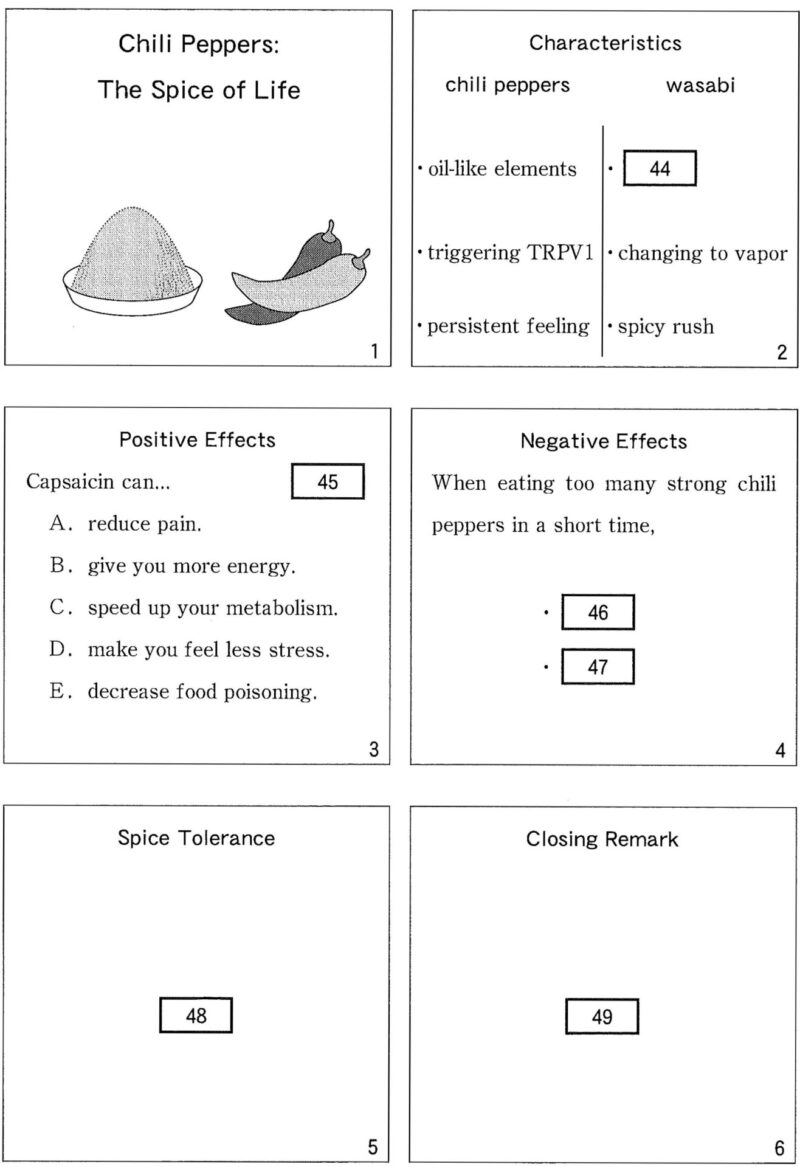2024年度の大学入学共通テスト英語第6問Bの解説をしています。疑問点が残らないよう、解き方の手順も踏まえて一問一問どこよりも丁寧に説明します。
問題
You are preparing a presentation for your science club, using the following passage from a science website.
Chili Peppers: The Spice of Life
Tiny pieces of red spice in chili chicken add a nice touch of color, but biting into even a small piece can make a person’s mouth burn as if it were on fire. While some people love this, others want to avoid the painful sensation. At the same time, though, they can eat sashimi with wasabi. This might lead one to wonder what spiciness actually is and to ask where the difference between chili and wasabi comes from.
Unlike sweetness, saltiness, and sourness, spiciness is not a taste. In fact, we do not actually taste heat, or spiciness, when we eat spicy foods. The bite we feel from eating chili peppers and wasabi is derived from different types of compounds. Chili peppers get their heat from a heavier, oil-like element called capsaicin. Capsaicin leaves a lingering, fire-like sensation in our mouths because it triggers a receptor called TRPV 1. TRPV 1 induces stress and tells us when something is burning our mouths. Interestingly, there is a wide range of heat across the different varieties of chili peppers, and the level depends on the amount of capsaicin they contain. This is measured using the Scoville Scale, which is also called Scoville Heat Units (SHU). SHUs range from the sweet and mild shishito pepper at 50-200 SHUs to the Carolina Reaper pepper, which can reach up to 2.2 million.
Wasabi is considered a root, not a pepper, and does not contain capsaicin. Thus, wasabi is not ranked on the Scoville Scale. However, people have compared the level of spice in it to chilis with around 1,000 SHUs, which is on the lower end of the scale. The reason some people cannot tolerate chili spice but can eat foods flavored with wasabi is that the spice compounds in it are low in density. The compounds in wasabi vaporize easily, delivering a blast of spiciness to our nose when we eat it.
Consuming chili peppers can have positive effects on our health, and much research has been conducted into the benefits of capsaicin. When capsaicin activates the TRPV 1 receptor in a person’s body, it is similar to what happens when they experience stress or pain from an injury. Strangely, capsaicin can also make pain go away. Scientists found that TRPV 1 ceases to be turned on after long-term exposure to chili peppers, temporarily eating painful sensations. Thus, skin creams containing capsaicin might be useful for people who experience muscle aches.
Another benefit of eating chili peppers is that they accelerate the metabolism. A group of researchers analyzed 90 studies on capsaicin and body weight and found that people had a reduced appetite when they ate spicy foods. This is because spicy foods increase the heart rate, send more energy to the muscles, and convert fat into energy. Recently, scientists at the University of Wyoming have created a wight-loss drug with capsaicin as a main ingredient.
It is also believed that chili peppers are connected with food safety, which might lead to a healthier life. When food is left outside of a refrigerated environment, microorganisms multiply on it, which may cause sickness if eaten. Studies have shown that capsaicin and other chemicals found in chili peppers have antibacterial properties that can slow down or even stop microorganism growth. As a result, food lasts longer and there are fewer food-bone illnesses. This may explain why people in hot climates have a tendency to use more chili peppers, and therefore, be more tolerant of spicier foods due to repeated exposure. Also, in the past, before there were refrigerators, they were less likely to have food poisoning than people in cooler climates.
Chili peppers seem to have health benefits, but can they also be bad for our health? Peppers that are high on the Scoville Scale can cause physical discomfort when eaten in large quantities. People who have eaten several of the world’s hottest chilis in a short time have reported experiencing upset stomachs, diarrhea, numb hands, and symptoms similar to a heart attack. Ghost peppers, which contain one million SHUs, can even burn a person’s skin if they are touched.
Luckily the discomfort some people feel after eating spicy foods tends to go away soon─usually within a few hours. Despite some negative side effects, spicy foods remain popular around the world and add a flavorful touch to the table. Remember, it is safe to consume spicy foods, but you might want to be careful about the amount of peppers you put it your dishes.
Presentation slides:

問1 What is the first characteristic of wasabi on Slide 2?
- burning taste
- fire-like sensation
- lasting feeling
- light compounds
問2 Which is an error you found on Slide 3?
- A
- B
- C
- D
- E
問3 Choose two options for Slide 4. (The order does not matter.)
- you might activate harmful bacteria.
- you might experience stomach pain.
- you might lose feeling in your hands.
- your fingers might feel like they are on fire.
- your nose might start hurting.
問4 What can be inferred about tolerance for spices for Slide 5?
- People with a high tolerance to chili peppers pay attention to the spices used in their food.
- People with a high tolerance to wasabi are scared of chili peppers’ negative effects.
- People with a low tolerance to chili peppers can get used to their heat.
- People with a low tolerance to wasabi cannot endure high SHU levels.
問5 Choose the most appropriate remark for Slide 6.
- Don’t be afraid. Eating spicy foods will boost your confidence.
- Next time you eat chili chicken, remember its punch only stays for a second.
- Personality plays a big role in our spice preference, so don’t worry.
- Unfortunately, there are no cures for a low wasabi tolerance.
- When someone offers you some spicy food, remember it has some benefits.
解説 問1
What is the first characteristic of wasabi on Slide 2?
「スライド2」のわさびの最初の特徴は何ですか
選択肢からワサビの特徴を選ぶ問題です。選択肢を確認しましょう。
1. burning taste
焼けるような味
2. fire-like sensation
火のような感覚
3. lasting feeling
持続的な感覚
4. light compounds
薄い混合物
「わさび」については、第三段落にこうあります。
The reason some people cannot tolerate chili spice but can eat foods flavored with wasabi is that the spice compounds in it are low in density.
唐辛子のスパイスが我慢できなくても、わさび味の食べ物は食べられる人がいるのは、その中に含まれるスパイス成分の濃度が低いためです。
「スパイス成分の濃度が低い」が選択肢「4」の「軽い混合物」に対応しています。
ということで、正解は「4」です。

「1」~「3」は全部「chili pepper」の内容ですね。唐辛子もワサビも食べたことがあるでしょうから、自身の経験からも選択肢が絞れそうです。
解説 問2
Which is an error you found on Slide 3?
スライド3で見つけた間違いはどれですか?
スライド3には、「Positive Effects / 好ましい効果」とあります。そこにカプサイシンができることとして、A~Eの五つの項目があります。その中で当てはまらないものを選ぶ問題です。一つ一つ確認していきましょう。
A. reduce pain.
痛みを軽減する
「痛み」について、第四段落にこうあります
Strangely, capsaicin can also make pain go away.
不思議なことに、カプサイシンは痛みを和らげることもあります。
「痛みを和らげる」とありますので、この選択肢は正しいです。
B. give you more energy.
よりエネルギーを与える
「エネルギー」について、第五段落にこうあります。
This is because spicy foods increase the heart rate, send more energy to the muscles, and convert fat into energy.
これは、辛い食べ物は心拍数を高め、より多くのエネルギーを筋肉に送り、脂肪をエネルギーに変換するためです。
カプサイシン自体がエネルギーになるわけではありませんが、結果的にエネルギーを筋肉に送ることになっています。この選択肢は正しいです。
C. speed up your metabolism.
代謝を促進する
「metabolism / 代謝」について、第五段落にこうあります
Another benefit of eating chili peppers is that they accelerate the metabolism.
唐辛子を食べることのもう一つの利点は、代謝を促進することです。
「代謝を促進する」とありますので、この選択肢は正しいです。
D. make you feel less stress.
ストレスを感じにくくする
「ストレス」について、第四段落にこうあります
When capsaicin activates the TRPV 1 receptor in a person’s body, it is similar to what happens when they experience stress or pain from an injury.
カプサイシンが人の体内の TRPV 1 受容体を活性化するとき、それはストレスや怪我による痛みを経験したときに起こる現象と似ています。
しかし「ストレスを感じにくくする」とは書かれてありません。これが間違いの選択肢です。
E. decrease food poisoning.
食中毒を減らす
「食中毒」について、第六段落にこうあります。
As a result, food lasts longer and there are fewer food-bone illnesses.
その結果、食べ物が長持ちし、食中毒が少なくなります。
食中毒が少なくなりますので、この選択肢は正しいです。
ということで間違いの選択肢は「D」なので、正解は「4」です。

「D」は該当部分の次の文に「痛みを和らげる」とあるのがいやらしいですね。「ストレスと痛み」をセットで出していましたので、「ストレス」も和らげるのではないかと錯覚しかねないです。ただしく文を読まなくてはいけません。
解説 問3
Choose two options for Slide 4. (The order does not matter.)
スライド4の選択肢を2つ選んでください。(順番は問いません)
スライド4は「Negative Effects / マイナスの効果」とあります。そしてその下にこうあります。
When eating too many strong chili peppers in a short time,
強い唐辛子を短期間にたくさん食べてしまうと、
これに続く文を、選択肢から2つ選ぶ問題です。選択肢を確認しましょう。
1. you might activate harmful bacteria.
有害な細菌を活性化させる可能性があります。
「細菌」について、第六段落にこうあります。
Studies have shown that capsaicin and other chemicals found in chili peppers have antibacterial properties that can slow down or even stop microorganism growth.
研究によると、唐辛子に含まれるカプサイシンやその他の化学物質には、微生物の増殖を遅らせ、さらには阻止する抗菌特性があることが示されています。
細菌を活性化させるのではなく、増殖を遅らせます。この選択肢は違います。
2. you might experience stomach pain.
腹痛を感じるかもしれません。
「腹痛」について、第七段落にこうあります。
People who have eaten several of the world’s hottest chilis in a short time have reported experiencing upset stomachs, diarrhea, numb hands, and symptoms similar to a heart attack.
短時間に世界で最も辛い唐辛子をいくつか食べた人は、胃のむかつき、下痢、手の麻痺、心臓発作のような症状を経験したと報告しています。
選択肢の「stomach pain」と本文の「upset stomachs」が対応しています。この選択肢が正解です。
3. you might lose feeling in your hands.
手の感覚を失う可能性があります。
「2」で確認した通り、短時間に唐辛子をたくさん食べると、「numb hands / 手の麻痺」を起こした人がいます。選択肢の「lose feeling in your hands / 手の感覚を失う」と対応していますので、この選択肢が正解です。
4. your fingers might feel like they are on fire.
指が燃えるように感じるかもしれません。
第七段落にこうあります。
Ghost peppers, which contain one million SHUs, can even burn a person’s skin if they are touched.
ゴーストペッパーには100万SHUが含まれており、触れた場合は皮膚に火傷を負うことさえあります。
選択肢の「feel like they are on fire / 指が燃えるように感じる」と、本文の「burn a person’s skin if they are touched / 触ると皮膚にやけどをする」が対応しています。ですがこれは、「触れたときに起きること」であり、問題文の「食べたときに起こること」ではありません。この選択肢は違います。
5. your nose might start hurting.
鼻が痛くなり始めるかもしれません。
「鼻」について、第三段落にこうあります。
The compounds in wasabi vaporize easily, delivering a blast of spiciness to our nose when we eat it.
わさびに含まれる成分は蒸発しやすく、食べると鼻に強烈な辛味を届けます。
ですが、これは「わさび」の話です。わさびについて、第三段落の最初にこうあります。
Wasabi is considered a root, not a pepper, and does not contain capsaicin.
わさびは唐辛子ではなく根菜とみなされ、カプサイシンは含まれません。
「わさび」と「唐辛子」は違います。スライド4は「唐辛子のマイナスの効果」なので、この選択肢は違います。
ということで、正解は「2」と「3」です。

「Negative Effects」なので、第七段落が該当部分だとはすぐに気づけるでしょう。選択肢の「4」は、スライドの「When eating too many strong chili pepper in a short time,」の部分を読んでいなければ、選んでしまいそうです。雑にしてはいけませんね。
解説 問4
What can be inferred about tolerance for spices for Slide 5?
スライド 5 のスパイスに対する耐性について何が推測できますか
選択肢を確認しましょう。
1. People with a high tolerance to chili peppers pay attention to the spices used in their food.
唐辛子に対する耐性が高い人は、食べ物に使用されるスパイスに注意を払います。
耐性が高いなら、スパイスに対して注意を払う必要はありませんよね。この選択肢は違います。
2. People with a high tolerance to wasabi are scared of chili peppers’ negative effects.
わさびに対する耐性が高い人は、唐辛子の悪影響を恐れています。
このような話はありません。この選択肢は違います。
3. People with a low tolerance to chili peppers can get used to their heat.
唐辛子に対する耐性が低い人でも、辛さに慣れることができます。
第六段落にこうあります。
This may explain why people in hot climates have a tendency to use more chili peppers, and therefore, be more tolerant of spicier foods due to repeated exposure.
これは、暑い気候の人々がより多くの唐辛子を使用する傾向があり、その結果、繰り返し触れることでより辛い食べ物に耐性を持つ理由を説明している可能性があります。
食べ続けていれば、辛いものも慣れていくのですね。この選択肢が正解です。
4. People with a low tolerance to wasabi cannot endure high SHU levels.
わさびに対する耐性が低い人は、高いSHUレベルに耐えることができません。
第三段落にこうあります。
some people cannot tolerate chili spice but can eat foods flavored with wasabi
唐辛子のスパイスが苦手でも、わさび味の食べ物は食べられる人がいる
ということは、わさびが苦手なら唐辛子は到底耐えられないように思えます。しかしわさびについては、第三段落にこうあります。
Wasabi is considered a root, not a pepper, and does not contain capsaicin.
わさびは唐辛子ではなく根菜とみなされ、カプサイシンは含まれません。
つまり「わさびの辛さ」と「唐辛子の辛さ」は全く別物なのです。なのでわさびが苦手でも唐辛子は大丈夫という人がいるかもしれません。この選択肢は違います。
ということで、正解は「3」です。

「4」を選びたくなります。わさびと唐辛子の辛さが別物なのは、うっかり読み飛ばしてしまいそう。わさびが苦手で唐辛子が大丈夫という人なら、自身の経験から消すことができたかもしれません。「3」の内容もさらっと書かれてありますので、読み飛ばしてしまいそうですね。
解説 問5
Choose the most appropriate remark for Slide 6.
スライド6に最も適切なコメントを選択してください。
スライド6は「Closing Remark / 締めの言葉」です。選択肢を確認しましょう。
1. Don’t be afraid. Eating spicy foods will boost your confidence.
恐れることはありません。辛いものを食べると自信がつきます。
辛い物を食べると自信がつくという話はありません。この選択肢は違います。
2. Next time you eat chili chicken, remember its punch only stays for a second.
次回チリチキンを食べるときは、その効果はほんの一瞬しか残らないことを覚えておいてください。
最終段落のこうあります。
Luckily the discomfort some people feel after eating spicy foods tends to go away soon─usually within a few hours.
幸いなことに、辛い食べ物を食べた後に一部の人が感じる不快感はすぐに消える傾向があり、通常は数時間以内に消えます。
「go away soon / すぐ消える」と書いてあります。ですが、そのあと補足で「数時間以内」とあります。「数時間以内」は、選択肢の「for a second / 一瞬」ではありません。またスライド2で、「chili pepper」の特徴として「persistent feeling / 持続的な感覚」とあります。この選択肢は違います。
3. Personality plays a big role in our spice preference, so don’t worry.
スパイスの好みには性格が大きく影響しますので、心配しないでください。
スパイスの好みに性格が影響するという話はありません。この選択肢は違います。
4. Unfortunately, there are no cures for a low wasabi tolerance.
残念ながら、わさび耐性の低さに対する治療法はありません。
唐辛子耐性の低い人でも、慣れれば食べられるようになるという話はありました。ですが、わさびについてそういう話は本文にありません。しかしだからと言って、「わさび耐性の低さに対する治療法がない」と言い切るのは、ちょっと言い過ぎです。この選択肢は違います。
5. When someone offers you some spicy food, remember it has some benefits.
誰かが辛い食べ物を勧めてきたら、それにはいくつかの利点があることを思い出してください。
本文でカプサイシンの利点について、いろいろと語られました。この選択肢が無難ではないでしょうか。
ということで、正解は「5」です。

まとめ的な問題です。消去法で選択肢を絞るのがいいでしょう。「1」「3」「4」などは内容的にも変ですから、消しやすいでしょう。




コメントをどうぞ